| Well we started looking around and after a lot of
"gee, I don't knows", and other cluckings, found a company, BeachTek (www.beachtek.com), in Canada, that
makes small mixing adaptors for nearly every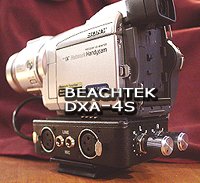 video camera out
there. Go to their website to find the right adaptor for your camera and local or online
dealers who sell them. For our Sony cams, we use BeachTek's DXA-4S, and
it has proved itself to be a very quiet and capable companion. It bolts right on to the
camcorder bottom, while the bottom of the unit itself, in turn, bolts on to your tripod
adaptor. A high quality short cable terminates with a stereo mini phone plug. The inputs
are high quality balanced XLR's with the option of using a mono mini phone plug as well.
This unit has mic/line switches that give you up to a 50db attenuation in signal and
volume controls for each of the two channels that allow you to have complete control over
the amount of signal level that reaches the mic input of the camera. This reduced signal
allows the ALC (auto level control) chip to handle the input with greater clarity and much
less noise. video camera out
there. Go to their website to find the right adaptor for your camera and local or online
dealers who sell them. For our Sony cams, we use BeachTek's DXA-4S, and
it has proved itself to be a very quiet and capable companion. It bolts right on to the
camcorder bottom, while the bottom of the unit itself, in turn, bolts on to your tripod
adaptor. A high quality short cable terminates with a stereo mini phone plug. The inputs
are high quality balanced XLR's with the option of using a mono mini phone plug as well.
This unit has mic/line switches that give you up to a 50db attenuation in signal and
volume controls for each of the two channels that allow you to have complete control over
the amount of signal level that reaches the mic input of the camera. This reduced signal
allows the ALC (auto level control) chip to handle the input with greater clarity and much
less noise.
These adaptors also have a mono/stereo switch that does a noble job of
summing the channels into a mono signal if desired, and even better, the thing is both
passive (requiring no power) and close to dead quiet. Now your camera's audio chip will
still produce some noise, especially if you reduce the input volume too much, or will
distort if you drive the signal too aggressively, but when used properly, this unit
suddenly gives you distinctly improved audio functionality to match the high quality video
signals these cameras are capable of producing. As you can see in the photo at right, this
is a very tidy little solution indeed to a major problem that is encountered by those who
want live audio with their live video. If you watch news crews much, you will see such
adaptors on even their high cost and larger professional full DVCAM and other broadcast
quality video equipment. Even though these very costly $5- 80 K, cameras have auto level
control overrides and pretty good internal audio mixing units with mic attenuation, many
still use the adaptors as they are more flexible and have better signal to noise specs.
You can use this adaptor to hook up your camera mic jack to a line level mixing output as
well. The signal remains quiet and the ability to record your live performance with
multiple instruments, including electric guitars and keyboards and effects simultaneously
with your video, makes a really fun and extremely functional creative solution.
The adaptors run a little under $200 and BeachTek makes them for nearly
every camcorder with a mic input. We were amazed to find few, if any, other companies
making such devices and applaud BeachTek for their quality and foresight. Even better, if
you already have a good camera with firewire, the audio you send to your video editor can
be stripped from the video and saved separately for mp3 compression. The
following mp3 clip of one of Legend Guitars' lower priced, non-hand made D112SFTGT
dreds follows. The sound was captured exactly as described above. With a good condenser
mic plugged into the DXA, the video was shot with the lens cap on and the audio was
subsequently stripped in the video editor and compressed as an mp3. The result was sweet,
quiet, and was accurately representative of this unbelievably fine $1000 guitar. The
DXA-4S is a one step solution for those with video cams who want to share their music on
the web. A good mic (almost anything is better than internal camera mics), $90 Ulead Video
7 software and a firewire connection is all you need.
 |
Midnight
Wind
Legend EXP
D112SFTGT |
Obviously for bigger budget sound, audio recording is not done in the
camera, but on high quality audio recorders and the subsequent two separate signals are
mixed and matched using time coding later in the A/V studio. While this will give one
optimum audio production quality, the software and sheer amount of equipment is an
unanticipated addition for those who bought good mini dvCams or other quality formats with
the hopes of simply producing some pretty nice A/V work. BeachTek was a real find and many
of the early mp3 tracks you will hear at Fingerpick as well as all of the audio (with a
few early exceptions), use the DXA-4S.
There are many good DV and Digital8 consumer cams out there that will
produce enviable results on a reasonable budget. Of course there are better solutions but
they come with a pretty quickly increasing cost. Three CCD mini dvCams like the Sony 950
will give you a bit better color and depth but often don't quite match the resolution of
the multi-mega pixel single CCDs. The Sony pro line starts at about two grand and goes up
quicky to nearly 100K. A final word of advice. There are quite a number of places on the
web that advertise very (suspiciously) low prices on digital video cameras. You will pay
more for such products at professional companies like B&H Photo but in some cases it
may be worth it. Many of the New York based discount camera dealers are really shady and
there are many sad tales to be told from folks who have dealt with them. One that seems to
be an anomaly is Butterfly Photo (www.butterflyphoto.com).
Their prices are much better than B&H and their service is pretty good as long as you
know what you want. We have had great luck with them. Discounts always come at a price and
consumers should realize that price should not be the only criteria when deciding on a
source for good quality equipment of any kind. Frankly, I have found Butterfly to be every
bit as helpful as B&H, who have a bit of an "attitude" to say the least and
Butterfly has much better pricing. There is a site that reviews customer experiences with
the reputed nest of New York discount dealers and you would be wise to read their ratings
before you spring for that "incredible" deal. The link to this consumer
protection/evaluation site is as follows: http://www.resellerratings.com/ Check it out. It may save you a lot of
hassles and, in the end, a lot of money as well. Sony, Panasonic, JVC and others all make
good stuff. We prefer the Sony line as through the years we have yet to have a Sony
product fail. Panasonic has been very reliable as well.
Finally, you need to understand the differences in various modern video
formats. We won't go into a long detailed piece here at this time, but 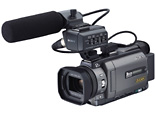 simply put, there are several superior video formats
available listed in increasing quality (and usually cost of equipment to acquire them) High8,
Digital8, microDV, miniDV, and dvCAM. The final one in the list is the most
professional of the group and does truly impressive uncompressed video. While true dvCAM
gives one better video, the tapes are much more expensive, and you get less time per tape.
The tracking heads are wider and provide better audio as well. The least expensive Sony we
know of that is in this professional range is the DSRPDX10 shown at left.
It has a 3CCD system, great resolution, and the little box on top, just below the
mic, is a audio mixing interface with simply put, there are several superior video formats
available listed in increasing quality (and usually cost of equipment to acquire them) High8,
Digital8, microDV, miniDV, and dvCAM. The final one in the list is the most
professional of the group and does truly impressive uncompressed video. While true dvCAM
gives one better video, the tapes are much more expensive, and you get less time per tape.
The tracking heads are wider and provide better audio as well. The least expensive Sony we
know of that is in this professional range is the DSRPDX10 shown at left.
It has a 3CCD system, great resolution, and the little box on top, just below the
mic, is a audio mixing interface with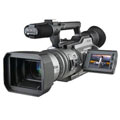 XLR inputs and a defeatable ALC, giving it great
self-contained onboard sound flexibility. There are mic attenuators and other features
that make this an incredibly good choice for those that have the nearly $2000 you can
expect to pay from a reputable dealer. It is small enough to serve most video enthusiasts
who don't like the idea of typical pro grade cameras 4 times its size (and ten times its
price). XLR inputs and a defeatable ALC, giving it great
self-contained onboard sound flexibility. There are mic attenuators and other features
that make this an incredibly good choice for those that have the nearly $2000 you can
expect to pay from a reputable dealer. It is small enough to serve most video enthusiasts
who don't like the idea of typical pro grade cameras 4 times its size (and ten times its
price).
Now the tried and true mini favorite of broadcasters and videographers
alike has been the DSR-VX2000. This 3CCD camera has been used extensively
for years for news and ad agency location shoots and has now been replaced by a new model,
the DSR-VX2100. Both have 3 CCD systems as well (all 3CCDs have one for
each color Red, Green, Blue - RGB) and though their pixel resolution per CCD is not
as high as some of the less expensive single CCD miniDVs, (these babies cost nearly $3000)
their onboard video processing chip is far better with the result being near broadcast
quality video on a miniDV. The DSRPDX10 will handle both
mini and full DVCAM, as well as true (not interpolated) widescreen 16:9 formats. This
along with its audio capabilities has sold us on it as our next camera. We have used it
and it is phenomenal, especially considering the next step up is nearly triple the price.
And it is still less expensive than the venerable but mini-DV only DSR-VX2100
shown above right. But let's be sensible for a moment and admit that both of these cameras
are way overkill for any web intended video. These cameras are for those who want to
produce pro quality broadcast and DVD media, unless of course, you simply like having the
best you can afford. And don't we all?
Audio Only
The field of audio recording systems has evolved so quickly over the last
few years, many find it difficult to make a clear decision on which way to go, including
how much to spend. Our recommendation is that you FIRST decide what you want to do with
audio and try to extrapolate how that may evolve in the future. Used, outdated recording
junk is worth little so you need to look at least 5 years in the future as to your
realistic intentions. I realize that this may be hard with current tendencies for entirely
new technologies to arrive sooner than that. But consider, CDs have been around for
fifteen years or so, and it is likely they will remain the predominant media for music
acquisition for some time to come. Even if DVD becomes the format of choice, the quality
of your recordings created with reasonably priced, currently existing equipment, should be
more than good enough for that time span. The real question remains what you intend to do
with your music. Do you want to simply archive, share it with friends, burn an occasional
CD or stream it on the web? Are you going to be recording others for a fee, or is this a
personal venture only?
Web Audio and More
Spending thousands of dollars on a recording system so you can share you
musical work on the web is, to be blunt, not logical. And with these higher price tag
systems comes steeper learning curves as well. Yet many folks do just that with the latest
state of the art recording equipment only to compress all of the advantages out of the
final work in order to get it to stream efficiently on the Internet. Sharing music on the
web is a great opportunity to test the waters as to the salability of your work. But like
demo recordings, music labels and prospective customers understand that it is the song,
talent and performance that is important, not the ultimate recording quality. They know if
a work has potential, it can be re-recorded with state of the art facilities and perhaps
even better performers. Nonetheless, there are great systems out there that are very low
cost and will sound absolutely wonderful at web streaming bandwidths and even burned to a
CD. Probably as good as most commercial recordings. Above we discussed the use of the
DXA-4S from BeachTek as a way to get your sound into MP3 format. You need the camcorder
and a little software, but if you have that it may be all you need to get your music heard
quite nicely by friends and online A&R companies like TAXI (www.taxi.com). However, you may not want
the additional baggage of video (and the relative fragility of video cameras). You also
may not like the idea of putting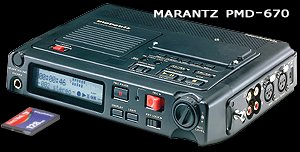 better, higher drain
audio capture cards in your computer that you do many other tasks on. I sure don't. A
music PC to be effective and reliable is usually best left to audio recording only.
However, there are solutions out there that will amaze you with their flexibility,
quality, and low cost. One of my favorites is the PMD 670 from Marantz. This little box,
about the size of a DAT portable (or a very, very small notebook computer) has high
quality balanced XLR inputs and a full range of controls from limiters to mic attenuators,
accepts line level signals as well, and records on Compact Flash Media. better, higher drain
audio capture cards in your computer that you do many other tasks on. I sure don't. A
music PC to be effective and reliable is usually best left to audio recording only.
However, there are solutions out there that will amaze you with their flexibility,
quality, and low cost. One of my favorites is the PMD 670 from Marantz. This little box,
about the size of a DAT portable (or a very, very small notebook computer) has high
quality balanced XLR inputs and a full range of controls from limiters to mic attenuators,
accepts line level signals as well, and records on Compact Flash Media.
This unit will record in every format from low to high quality MP3s, mpgs,
to fully uncompressed PCM wave files. Its specs exceed DAT decks costing many times as
much and it is simple to use and dead quiet. The recordings 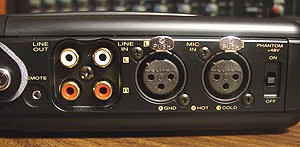 you can make on this stereo unit are impressive to
say the least even in the MP3 format. With its USB connection you can plug it into your
computer, (which sees it as simply another hard drive) and immediately post/share your
files or burn a CD. The PMD runs on AA batteries, or a rechargeable battery pack as well
as on an included AC adaptor. Typically 8 AA alkalines last at least 6 hours of continuous
recording and several days in the field with typical recording procedures where the
machine is off more than on. Even better, a 512mb Flash media card will hold 3.5 hours of
pristine 320 kbps mp3 stereo heaven and about 45 minutes of studio ready 48Khz
uncompressed PCM (.wav). It also has digital S/PDIF in and out, and frankly all it doesn't
do is multitrack. But for location sound, sampling, or to get a sensational rendering of
your musical performance out to the public quickly, we have not found its equal anywhere
near its $700US price. So for those of you who are looking for a recording solution to get
your guitar playing on the web you can make on this stereo unit are impressive to
say the least even in the MP3 format. With its USB connection you can plug it into your
computer, (which sees it as simply another hard drive) and immediately post/share your
files or burn a CD. The PMD runs on AA batteries, or a rechargeable battery pack as well
as on an included AC adaptor. Typically 8 AA alkalines last at least 6 hours of continuous
recording and several days in the field with typical recording procedures where the
machine is off more than on. Even better, a 512mb Flash media card will hold 3.5 hours of
pristine 320 kbps mp3 stereo heaven and about 45 minutes of studio ready 48Khz
uncompressed PCM (.wav). It also has digital S/PDIF in and out, and frankly all it doesn't
do is multitrack. But for location sound, sampling, or to get a sensational rendering of
your musical performance out to the public quickly, we have not found its equal anywhere
near its $700US price. So for those of you who are looking for a recording solution to get
your guitar playing on the web to
share with your forum buddies, this one is a no brainer. It also has high quality line
in/out RCA jacks that accept silently the output of your mixer, which makes it ideal for a
more finished sound with effects, multiple instruments, keyboards, and yes, even your
electric guitar. Few people we know can tell the difference between a 320 Kbps mp3 and a
CD recording. We recorded some CDs on to this thing when it first arrived and I will tell
you the MP3 quality is amazing. It will also record much more highly compressed MP3s
giving you 8 + hours of recording at 128Kbhs which still sounds extremely sweet and are
more than good enough for web work. to
share with your forum buddies, this one is a no brainer. It also has high quality line
in/out RCA jacks that accept silently the output of your mixer, which makes it ideal for a
more finished sound with effects, multiple instruments, keyboards, and yes, even your
electric guitar. Few people we know can tell the difference between a 320 Kbps mp3 and a
CD recording. We recorded some CDs on to this thing when it first arrived and I will tell
you the MP3 quality is amazing. It will also record much more highly compressed MP3s
giving you 8 + hours of recording at 128Kbhs which still sounds extremely sweet and are
more than good enough for web work.
It comes with a 64MB flash card, but we recommend the 512MB (around $90 on
sale). The attenuators give you a flat 0 to -20 db pad and its limiter is noiseless and
very effective if you chose to use it. Also included are both bass only and bass/treble
roll off switches (never needed them) and switchable +48v phantom power for those
condenser mics that need it. And having no moving parts, it should last literally forever.
Full size 1/4" headphone jacks that are as sweet as you will hear at any price.
I use
this thing as the audio recorder for my DVCAMS as well and sync the sound later in my
editing programs when doing higher than web quality work. I recorded a rainstorm last
week, using a stereo field mic I will discuss below for use in a music sound track in
ProTools and the results were so life-like that every time I listen to this cut, I
continue to get the uncontrollable urge to pee. Sweetwater (www.sweetwater.com) has this unit in
stock (call Brian Loney at 800-222-4700 ext 1310) and though it might be nice to keep this
one a secret and let people figure out how I get the quality location sounds I do, I could
not resist sharing its existence with our readers. I too often see folks on forums
agonizing over ways to get their guitar playing into their computer and out on the web,
contemplating the IRQ and compatibility madness of audio capture cards and software that
is designed for far more duty than they intend to use. This is an incredibly simple and
robust solution for them as well as for the pro looking for great location portable
recording capability. I'm heading to Vegas next month for a show and then Arizona for the
end of Spring Training after which, my guitars, mics, cameras, and my PMD-670 will be
heading for the mesas of Sedona for some environmentally soothing outdoor writing and
recording. Nothing like a full yellow moon on top of a red rock mesa to inspire one
musically.
By the way, regarding Sweetwater, I have been dealing with
Brian there for what must be nearly 8 years now. He, like all the folks there, know every
nuance of everything thing they sell. They call themselves sales engineers and that title
is well deserved. It is rare to find any equipment source who is able to keep top people
like Brian for so many years and who know their extensive line of pro grade products so
well. But I digress:
A Portable Studio?

Well . . . yes the above recorder and a transparent, quiet and rugged
stereo field mike that is not so expensive to cause heart failure if broken with a great
pair of cans (headphones) is pretty much heaven for those like me who sometimes feel more
creative outside the formality of even my own studio. ProTools is great and all the
whizbang gadgets that make sound come alive are there waiting for me, but sometimes my
creative energy needs a drive in a fast sports car on a mountain road with a quiet private
spot at journey's end to put my inspiration into the digital world. The system shown above
will do all I need in such situations.
The
microphone is a stereo Audio-Technica 822 condenser which you will be hearing a lot from
in this magazine. I have better mics I suppose, large tube condensers that weigh as much
as an old Martin 00 and cost as much as a good used car, but this mic is special. The more
expensive 825 (we A/B'd two of each before buying) has better frequency specs, costs about
a hundred more, and is intended for studio work. However, the higher frequency
response/sensitivity actually caused the 825 to exhibit more self-noise. The difference
between 20-20khz and 20-21khz for some reason allowed for more high end pollution in the
825 than the 822. Our 822 is dead quiet, at least to the degree that the content it
provides has no discernable sound that degrades its use in even high end mixes. It uses a
single AA battery and thus needs no phantom power. The battery lasts about a thousand
hours but we have yet to wear one out (we trun it off when not in use). It has a low cut
filter if needed for close miking but at one foot from a guitar, is dead quiet in the
studio and picks up crickets, water and wind with no "pop/blast" if you are
outside and want the extra ambience. We use this with our dvCams and the DXA-4S Beachtek
adaptor initially for some of the web video recordings in this magazine as well as for
some of the MP3s. (Obviously, now we use the PMD-670 as its audio chip is far superior to
anything we found in cameras, even in the high 5 figure range). It comes with both a
1/8" stereo mini phone plug for direct hookup to the camera hot shoe as well as a
3+meter stereo cable terminated in two 1/4 balanced phone jacks which we put high grade
balanced XLR adaptors on for everything. Mixers, adaptors, recorders - all like the XLR
connection better. The stereo field properties of this mic is breathtaking in its
presence. To say the sound is realistic is an understatement. We looked at two other
stereo mics, one at $500 (Rode - we love Rode products) and one at $7500 (a Manley) and
honestly could not justify their price for remote web content. Of course these two higher
priced mics are outstanding for studio recording, but at around $250, the 822 should
satisfy even very picky recordists although, again and especially, the $7500 Manley Gold
Reference knocked our socks off. However, the idea of taking a mic that expensive out of
the studio was idiotic.
Now you may ask why stereo mics at all. Well the fact is sound engineers
often spend hours setting up two or more mics for acoustic guitar recording and the
dialogues I have seen on certain forums about mic placement confirm what I have found over
the years. Two separate mics are a pain in the ass, as each guitar and player is so
different that there is no such thing as "the" perfect location for two mics.
With this stereo single, the sweet spot was found instantly and it varies little for each
guitar. Again the sole point of any equipment is to do an optimal job without interfering
with the user's creative inspiration, which can be extremely fleeting. I want systems that
are idiot proof and engineer obsolescent. Every hour I spend in setup results in many
hours of lost inspiration. So yes, if I was recording someone besides myself and those I
work with frequently and charging them a bunch of bucks, I might be tempted towards higher
end solutions like the large mono tube condensers we use for the studio. However, I seldom
record others and even so the difference in the very high end and the great compromises I
have found over the years are, in most cases, truly negligible. It's the performance
stupid. (This I say to myself a lot so don't be offended.) At any rate, there are other
mics in my studio I will talk about from time to time that represent great value and great
sound that compare favorably with high end Neumann and others for my uses. There are many
great mics at all price levels and few truly bad ones anymore. For now suffice it to say
that the 822 will give you an incredibly efficient, transparent and sweet acoustic and
vocal performance and save you enough money to buy a new pair of strings once in a while.
By the way, I mic my acoustics for this magazine so I can talk as well with the mic just
about lower lip level and about 9" to a foot away so it picks up both guitar and my
rhetorical ramblings equally. Here is a sample of the mic and voice through the camcorder
and Beachtek adaptor. For guitar only miking, I would put the mic closer, pointed down a
tidge and a little lower but still well above the guitar. I think you will get some idea
of this mic's quality even from a non optimum position for the guitar as well as the
interesting possibilities of the DXA-4S camera audio adaptor when used as described above.
Again, the sound track was stripped from the video and compressed to mp3. Wait 'til you
hear the mic with the Marantz PDM-670. Coming in a day or so along with much more on
various higher end recording systems and mics! But for now, the separated audio from an
instructional clip on the Guitar Basics page:
 |
| MP3 |
The headphones shown above, at the top of this section, that complete the
portable studio are the Sony MDR-7509. Though the less expensive MDR 7506 are more popular
and less expensive, I like the added bottom and top end response of the '09s as they more
accurately reflect real world quality speaker systems. They are sweet and rugged are very
isolating and yet very airy. I have several of each as well as a couple of the older
V-600s and two pairs of the Senn 280 Pros which shut out as much outside sound as good
shooter's headphones. I still prefer the '09s for serious headphone monitoring unless I am
at the pistol range. The point is, just as good speakers are the most important part of
any sound system, good headphones will make your listening far more enjoyable and better
match your final amplified speaker sound which is always the final test.
Now since the above was
written we have converted to using the PMD-670 for a lot of our remote sessions. However,
when we know clean power is going to be available and when we want to provide a finished
product with reverb and other ambient enhancments our favorite "rack" system is
the one shown at left. Instead of the PMD-670 we use the rack mountable Alesis Masterlink
9600 High Rsolution Hard Disk Mastering Recorder. This 40 Gig hard drive wonder records
effortlessly at 24/96 giving you about 20 hours of time and does so with absolutely no
latency or artifacting. It is used in the film industry a lot and is the mastering deck of
choice of many top end studios. At about a $1000 street price there is simply no finer
solution we have found to capture high end two track sound. It has a built in cd burner
and will not only make your cd's for you (remember cd quality is always 16bit / 44.1 Khz)
ut will allow you to archive at 24/96 onto cd and then get them into your final DAW
computer based or otherwise. It has a host of real world functions that make it the best
deal on the planet. S/PDIF, RCA and other connections are all provided and in the rack it
is a silent mighty partner.
The mixer we use for location
(we have several of these as one never knows when a great product will suddenly go out of
production
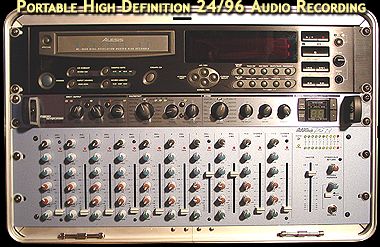 The headphones shown above, at the top of this
section, that complete the portable studio are the Sony MDR-7509. Though the less
expensive MDR 7506 are more popular and less expensive, I like the added bottom and top
end response of the '09s as they more accurately reflect real world quality speaker
systems. They are sweet and rugged. I have several of each as well as a couple of the
older V-600s and two pairs of the Senn 280 Pros which shut out as much outside sound as
good shooter's headphones. I still prefer the '09s for serious monitoring unless I am at
the pistol range. The point is, just as good speakers are the most important part of any
sound system, good headphones will make your listening far more enjoyable and better match
your final amplified speaker sound. Remember, there's a lot more to come soon! - Doug The headphones shown above, at the top of this
section, that complete the portable studio are the Sony MDR-7509. Though the less
expensive MDR 7506 are more popular and less expensive, I like the added bottom and top
end response of the '09s as they more accurately reflect real world quality speaker
systems. They are sweet and rugged. I have several of each as well as a couple of the
older V-600s and two pairs of the Senn 280 Pros which shut out as much outside sound as
good shooter's headphones. I still prefer the '09s for serious monitoring unless I am at
the pistol range. The point is, just as good speakers are the most important part of any
sound system, good headphones will make your listening far more enjoyable and better match
your final amplified speaker sound. Remember, there's a lot more to come soon! - Doug
Though the less expensive MDR 7506 are more popular and less expensive, I
like the added bottom and top end response of the '09s as they more accurately reflect
real world quality speaker systems. They are sweet and rugged. I have several of each as
well as a couple of the older V-600s and two pairs of the Senn 280 Pros which shut out as
much outside sound as good shooter's headphones. I still prefer the '09s for serious
monitoring unless I am at the pistol range. The point is, just as good speakers are the
most important part of any sound system, good headphones will make your listening far more
enjoyable and better match your final amplified speaker sound. Remember, there's a lot
more to come soon! - Doug
|




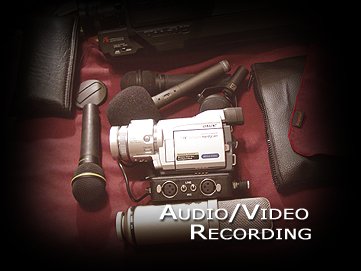


 simply put, there are several superior video formats
available listed in increasing quality (and usually cost of equipment to acquire them) High8,
Digital8, microDV, miniDV, and dvCAM. The final one in the list is the most
professional of the group and does truly impressive uncompressed video. While true dvCAM
gives one better video, the tapes are much more expensive, and you get less time per tape.
The tracking heads are wider and provide better audio as well. The least expensive Sony we
know of that is in this professional range is the DSRPDX10 shown at left.
It has a 3CCD system, great resolution, and the little box on top, just below the
mic, is a audio mixing interface with
simply put, there are several superior video formats
available listed in increasing quality (and usually cost of equipment to acquire them) High8,
Digital8, microDV, miniDV, and dvCAM. The final one in the list is the most
professional of the group and does truly impressive uncompressed video. While true dvCAM
gives one better video, the tapes are much more expensive, and you get less time per tape.
The tracking heads are wider and provide better audio as well. The least expensive Sony we
know of that is in this professional range is the DSRPDX10 shown at left.
It has a 3CCD system, great resolution, and the little box on top, just below the
mic, is a audio mixing interface with XLR inputs and a defeatable ALC, giving it great
self-contained onboard sound flexibility. There are mic attenuators and other features
that make this an incredibly good choice for those that have the nearly $2000 you can
expect to pay from a reputable dealer. It is small enough to serve most video enthusiasts
who don't like the idea of typical pro grade cameras 4 times its size (and ten times its
price).
XLR inputs and a defeatable ALC, giving it great
self-contained onboard sound flexibility. There are mic attenuators and other features
that make this an incredibly good choice for those that have the nearly $2000 you can
expect to pay from a reputable dealer. It is small enough to serve most video enthusiasts
who don't like the idea of typical pro grade cameras 4 times its size (and ten times its
price).  better, higher drain
audio capture cards in your computer that you do many other tasks on. I sure don't. A
music PC to be effective and reliable is usually best left to audio recording only.
However, there are solutions out there that will amaze you with their flexibility,
quality, and low cost. One of my favorites is the PMD 670 from Marantz. This little box,
about the size of a DAT portable (or a very, very small notebook computer) has high
quality balanced XLR inputs and a full range of controls from limiters to mic attenuators,
accepts line level signals as well, and records on Compact Flash Media.
better, higher drain
audio capture cards in your computer that you do many other tasks on. I sure don't. A
music PC to be effective and reliable is usually best left to audio recording only.
However, there are solutions out there that will amaze you with their flexibility,
quality, and low cost. One of my favorites is the PMD 670 from Marantz. This little box,
about the size of a DAT portable (or a very, very small notebook computer) has high
quality balanced XLR inputs and a full range of controls from limiters to mic attenuators,
accepts line level signals as well, and records on Compact Flash Media.  you can make on this stereo unit are impressive to
say the least even in the MP3 format. With its USB connection you can plug it into your
computer, (which sees it as simply another hard drive) and immediately post/share your
files or burn a CD. The PMD runs on AA batteries, or a rechargeable battery pack as well
as on an included AC adaptor. Typically 8 AA alkalines last at least 6 hours of continuous
recording and several days in the field with typical recording procedures where the
machine is off more than on. Even better, a 512mb Flash media card will hold 3.5 hours of
pristine 320 kbps mp3 stereo heaven and about 45 minutes of studio ready 48Khz
uncompressed PCM (.wav). It also has digital S/PDIF in and out, and frankly all it doesn't
do is multitrack. But for location sound, sampling, or to get a sensational rendering of
your musical performance out to the public quickly, we have not found its equal anywhere
near its $700US price. So for those of you who are looking for a recording solution to get
your guitar playing on the web
you can make on this stereo unit are impressive to
say the least even in the MP3 format. With its USB connection you can plug it into your
computer, (which sees it as simply another hard drive) and immediately post/share your
files or burn a CD. The PMD runs on AA batteries, or a rechargeable battery pack as well
as on an included AC adaptor. Typically 8 AA alkalines last at least 6 hours of continuous
recording and several days in the field with typical recording procedures where the
machine is off more than on. Even better, a 512mb Flash media card will hold 3.5 hours of
pristine 320 kbps mp3 stereo heaven and about 45 minutes of studio ready 48Khz
uncompressed PCM (.wav). It also has digital S/PDIF in and out, and frankly all it doesn't
do is multitrack. But for location sound, sampling, or to get a sensational rendering of
your musical performance out to the public quickly, we have not found its equal anywhere
near its $700US price. So for those of you who are looking for a recording solution to get
your guitar playing on the web to
share with your forum buddies, this one is a no brainer. It also has high quality line
in/out RCA jacks that accept silently the output of your mixer, which makes it ideal for a
more finished sound with effects, multiple instruments, keyboards, and yes, even your
electric guitar. Few people we know can tell the difference between a 320 Kbps mp3 and a
CD recording. We recorded some CDs on to this thing when it first arrived and I will tell
you the MP3 quality is amazing. It will also record much more highly compressed MP3s
giving you 8 + hours of recording at 128Kbhs which still sounds extremely sweet and are
more than good enough for web work.
to
share with your forum buddies, this one is a no brainer. It also has high quality line
in/out RCA jacks that accept silently the output of your mixer, which makes it ideal for a
more finished sound with effects, multiple instruments, keyboards, and yes, even your
electric guitar. Few people we know can tell the difference between a 320 Kbps mp3 and a
CD recording. We recorded some CDs on to this thing when it first arrived and I will tell
you the MP3 quality is amazing. It will also record much more highly compressed MP3s
giving you 8 + hours of recording at 128Kbhs which still sounds extremely sweet and are
more than good enough for web work.

 The headphones shown above, at the top of this
section, that complete the portable studio are the Sony MDR-7509. Though the less
expensive MDR 7506 are more popular and less expensive, I like the added bottom and top
end response of the '09s as they more accurately reflect real world quality speaker
systems. They are sweet and rugged. I have several of each as well as a couple of the
older V-600s and two pairs of the Senn 280 Pros which shut out as much outside sound as
good shooter's headphones. I still prefer the '09s for serious monitoring unless I am at
the pistol range. The point is, just as good speakers are the most important part of any
sound system, good headphones will make your listening far more enjoyable and better match
your final amplified speaker sound. Remember, there's a lot more to come soon! - Doug
The headphones shown above, at the top of this
section, that complete the portable studio are the Sony MDR-7509. Though the less
expensive MDR 7506 are more popular and less expensive, I like the added bottom and top
end response of the '09s as they more accurately reflect real world quality speaker
systems. They are sweet and rugged. I have several of each as well as a couple of the
older V-600s and two pairs of the Senn 280 Pros which shut out as much outside sound as
good shooter's headphones. I still prefer the '09s for serious monitoring unless I am at
the pistol range. The point is, just as good speakers are the most important part of any
sound system, good headphones will make your listening far more enjoyable and better match
your final amplified speaker sound. Remember, there's a lot more to come soon! - Doug